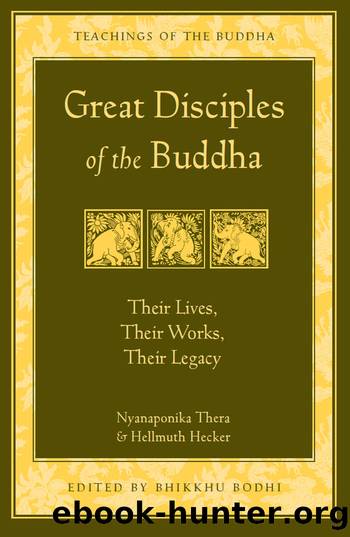Great Disciples of the Buddha: Their Lives, Their Works, Their Legacy by Nyanaponika & Hellmuth Hecker

Author:Nyanaponika & Hellmuth Hecker [Hecker, Hellmuth]
Language: eng
Format: epub
Tags: Buddhism
ISBN: 9780861718641
Google: PbfmHoSYVQAC
Publisher: Simon and Schuster
Published: 2012-01-30T01:23:37+00:00
THE STRUGGLE FOR ARAHANTSHIP
The divine eye is the ability to see beyond the range of the physical eye, extending in Anuruddhaâs case to a thousandfold world system. This faculty, which we will discuss more fully below, is of a mundane (lokiya) character, one whose acquisition does not necessarily entail that its possessor has gained realization of the Dhamma. Anuruddha attained the divine eye before he became an arahant, and to reach the heights he still had to overcome many inner obstacles. Three reports in the canon tell of his struggles.
Once, when the Venerable Anuruddha was living in the Eastern Bamboo Park with two friends, his cousin Nandiya and the Sakyan noble Kimbila, the Buddha visited them and inquired about their progress.4 Anuruddha then told him about a difficulty he had experienced in a very sublime meditation he had been practicing. He had perceived an inner light and radiance and had a vision of sublime forms.5 But that light and vision of forms disappeared very soon, and he could not understand the reason.
The Buddha declared that when he was still striving for enlightenment he too had met the same difficulty but had discovered how to master it. He explained that to experience these subtle states in full and obtain a steady perception of them one should free oneself from eleven imperfections (upakkilesa). The first is uncertainty about the reality of these phenomena and the significance of the inner light, which might easily be taken for a sensory illusion. The second is inattention: one no longer directs oneâs full attention to the inner light but disregards it, evaluating it as unremarkable or inessential. The third imperfection is lethargy and drowsiness; the fourth, anxiety and fright, which occurs when threatening images or thoughts arise from the subconscious. When these imperfections have been mastered, elation may arise, which excites body and mind. Such exultation is often a habitual reaction to any kind of success. When that elation has exhausted itself, one may feel emotionally drained and fall into inertia, a heavy passivity of mind. To overcome it, one makes a very strong effort, which may result in an excess of energy. On becoming aware of this excess, one relaxes and falls again into sluggish energy. In such a condition, when mindfulness is weak, strong longing may arise for desirable objects of the celestial or the human world, according to the focusing of the inner light which had been widened in its range. This longing will reach out to a great variety of objects and thus lead to another imperfection, a large diversity of perceptions, be it on the celestial or human plane. Having become dissatisfied with this great diversity of forms, one chooses to contemplate one of them, be it of a desirable or undesirable nature. Concentrating intensely on the chosen object will lead to the eleventh imperfection, the excessive meditating on these forms.
Addressing Anuruddha and his two companions the Buddha thus described vividly, from his own experience, the eleven imperfections that may arise in the meditative perception of pure forms, and he explained how to overcome them (MN 128).
Download
This site does not store any files on its server. We only index and link to content provided by other sites. Please contact the content providers to delete copyright contents if any and email us, we'll remove relevant links or contents immediately.
The Lost Art of Listening by Michael P. Nichols(7169)
Why I Am Not A Calvinist by Dr. Peter S. Ruckman(4048)
The Rosicrucians by Christopher McIntosh(3373)
Wicca: a guide for the solitary practitioner by Scott Cunningham(3045)
Signature in the Cell: DNA and the Evidence for Intelligent Design by Stephen C. Meyer(2879)
Real Sex by Lauren F. Winner(2869)
The Holy Spirit by Billy Graham(2779)
To Light a Sacred Flame by Silver RavenWolf(2680)
The End of Faith by Sam Harris(2637)
The Gnostic Gospels by Pagels Elaine(2400)
Waking Up by Sam Harris(2332)
Nine Parts of Desire by Geraldine Brooks(2283)
Jesus by Paul Johnson(2230)
Devil, The by Almond Philip C(2207)
The God delusion by Richard Dawkins(2192)
Heavens on Earth by Michael Shermer(2190)
Kundalini by Gopi Krishna(2094)
Chosen by God by R. C. Sproul(2057)
The Nature of Consciousness by Rupert Spira(1983)
